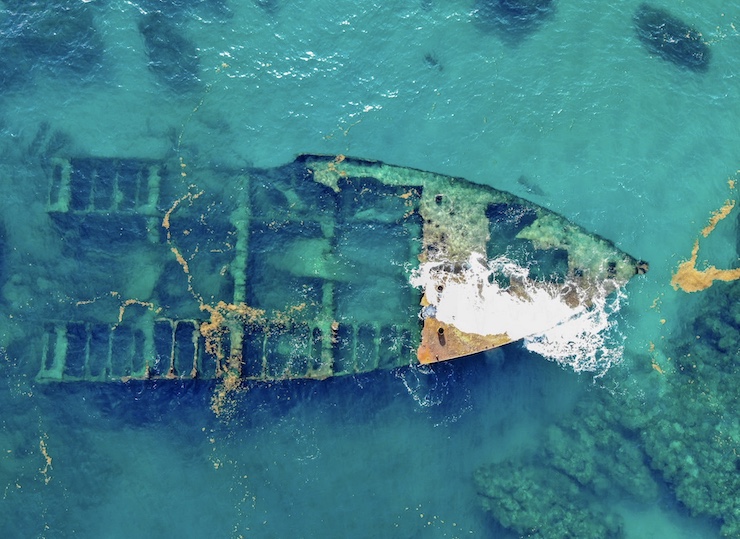
The United Nations estimates that three million shipwrecks litter the ocean floor. Some of the most sought after vessels are ships thought to contain sunken treasure. Finding them – and extracting their hidden riches – has never been easy. Most of these seafaring expeditions fail in the end. But thanks to a new underwater search vehicle – the deep-sea submersible drone – treasure hunters are beginning to find long-lost Spanish galleons and other ships filled with gold, silver and emeralds and artifacts of immense historical value.
In 2015, the Spanish galleon San Jose, long considered the “holy grail of shipwrecks” – which sank after a battle with British ships off the coast of Cartagena, Colombia, in 1708 – was discovered with the help of an underwater drone called the REMUS 6000. Supported by the Woods Hole Oceanic Institution (WHOI), the month-long drone expedition, using sophisticated high-resolution sonar cameras, was able to identify the three-masted galleon by its distinctive suite of 62 cannons. The unexpected find was heralded by Colombia’s president and touched off an all-day celebration.
Four years earlier, the same REMUS drone had played an instrumental role in finding the wreckage – including the precious “black boxes” – of Air France 447, which had crashed in 2009, killing all of its passengers and crew. And in 2017, multi-millionaire Paul Allen deployed a REMUS 6000 to find the infamous USS Indianapolis – the Navy cruiser credited with delivering the two atomic bombs dropped on Japan in 1945 and later torpedoed by the Japanese Navy – at a depth of nearly 18,000 feet in the Philippine Sea.
Underwater drones have also aided the search for shipwrecked passenger steamships in which hundreds and even thousands of people lost their lives. Last month, two Seattle WA explorers finally stumbled upon the location of the SS Pacific after 10 years of constant but fruitless quests to find the vessel. The legendary steamship, which sank in 1875, was carrying gold worth $5 million today. More than 300 passengers perished when it was struck by a schooner that mistook the vessel for a lighthouse.
Drones have helped step up the pace of these underwater searches – as well as their success. In March 2022, a drone search sponsored by Saab, the Swedish company best known for its automobiles, resulted in another remarkable find: the location of the Endurance, the Arctic exploration vessel of famed Mount Everest expedition leader Ernest Shackleton that sank in 1915. Saab’s aerospace and defense division deployed two “Sabertooth” drones that can operate underwater for up to six months and dive to a depth of nearly 10,000 feet – roughly the depth at which the Endurance was eventually found.
While private parties and non-profits often sponsor underwater ship searches, governments are becoming increasingly involved. For example, the National Oceanic and Atmospheric Administration (NOAA), in conjunction with key partner agencies, now conducts its own taxpayer-funded investigations of historical shipwrecks, in part because the metal from sunken vessels can damage coral reefs and fish habitats. Last May, NOAA conducted an underwater drone expedition in and around the Monitor National Marine Sanctuary in the Cape Hatteras region off the coast of North Carolina. A separate NOAA expedition has plumbed the depths of Lake Ohio as part of the agency’s special Great Lakes Initiative.
Underwater searches aren’t just conducted to the depths of the ocean floor; increasingly, they delve below the floor – up to 30 feet below – allowing even more deeply buried treasures and vessels to be discovered. The most sophisticated of the new drones utilize a special sensor technology, enhanced with artificial intelligence, that emits radio waves and other electric impulses to identify and distinguish various kinds of deeply buried metals. In August 2022, a Florida-based company, Seafarer, field tested a drone equipped with new 3-D imaging technology that can map the terrain of an ocean seabed. The private company has secured exclusive rights to explore the state’s coastal depths in the hopes of finding more of the hundreds of Spanish galleons loaded with gold and other riches that sailed from Cuba and then sank during storms en route to Europe after plundering the New World.
Experts say the search for sunken ships and treasures is really just beginning. To date, just 1% of the total number of estimated shipwrecked vessels have been identified, and far fewer have received serious exploration. Thanks to increasingly sophisticated underwater drone technology, and the growing interest among governments, private companies and philanthropists, more such underwater searches can be launched, with greater chances of success.
|